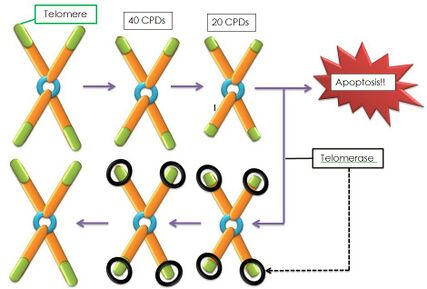Telomere: Difference between revisions
No edit summary |
No edit summary |
||
| Line 6: | Line 6: | ||
== Introduction == | == Introduction == | ||
[[File:Telomerase&Telomeres.jpeg|thumb|427x427px|The affect of telomerase on the length of telomeres. ]] | [[File:Telomerase&Telomeres.jpeg|thumb|427x427px|The affect of telomerase on the length of telomeres. ]] | ||
Telomeres are repetitive deoxyribonucleic acid (DNA) sequences which cap the ends of chromosomes, protecting them from degradation, unlike the | Telomeres are repetitive deoxyribonucleic acid (DNA) sequences which cap the ends of chromosomes, protecting them from degradation, note unlike the parts of the DNA they not contain information needed to make proteins. With every cell division the telomere shortens and when a critical telomere length is attained, cellular replication can no longer take place, and it becomes “senescent”. To counter this shortening telomerase plays a critical role. Telomerase is an enzyme in that repairs the telomeres of the chromosomes so that they do not become progressively shorter during successive rounds of chromosome replication. The telomeres themselves in turn are protected by protein complexes called “shelterins”. These shelterins role is to regulate telomerase activity on the telomere and prevent telomerase overactivity to avoid excessive telomere elongation<ref>Haupt S, Niedrist T, Sourij H, Schwarzinger S, Moser O. The Impact of Exercise on Telomere Length, DNA Methylation and Metabolic Footprints. Cells 2022, 11, 153. Available:https://www.ncbi.nlm.nih.gov/pmc/articles/PMC8750279/ (accessed 23.7.2022)</ref>. | ||
== Sub Heading 2 == | == Sub Heading 2 == | ||
Revision as of 13:26, 23 July 2022
Original Editor - Lucinda hampton
Top Contributors - Lucinda hampton, Vidya Acharya and Tolulope Adeniji
Introduction[edit | edit source]
Telomeres are repetitive deoxyribonucleic acid (DNA) sequences which cap the ends of chromosomes, protecting them from degradation, note unlike the parts of the DNA they not contain information needed to make proteins. With every cell division the telomere shortens and when a critical telomere length is attained, cellular replication can no longer take place, and it becomes “senescent”. To counter this shortening telomerase plays a critical role. Telomerase is an enzyme in that repairs the telomeres of the chromosomes so that they do not become progressively shorter during successive rounds of chromosome replication. The telomeres themselves in turn are protected by protein complexes called “shelterins”. These shelterins role is to regulate telomerase activity on the telomere and prevent telomerase overactivity to avoid excessive telomere elongation[1].
Sub Heading 2[edit | edit source]
Sub Heading 3[edit | edit source]
Resources[edit | edit source]
- bulleted list
- x
or
- numbered list
- x
References[edit | edit source]
- ↑ Haupt S, Niedrist T, Sourij H, Schwarzinger S, Moser O. The Impact of Exercise on Telomere Length, DNA Methylation and Metabolic Footprints. Cells 2022, 11, 153. Available:https://www.ncbi.nlm.nih.gov/pmc/articles/PMC8750279/ (accessed 23.7.2022)







